Gender Identity and Social Status through the Performance pdf
Research Scholar, Manipuri Dance, Sangit Bhavan, Visva Bharati, Santiniketan, West Bengal, India
Abstract: The paper delves into the rich spiritual tradition of the Amaibis, the shamans of Manipur with special emphasis on the compelling presence of the Nupa Amaibis, a figure that offers a transformative perspective on gender and ritual performance in Meitei society. Unlike the exclusively male role of the Amaiba, the Amaibi tradition is marked by its inclusively, embracing both Nupa Amaibis (male bodied shaman who embody feminine role) and Nupi Amaibis (female bodied shamans). This framework underscores deeply embedded gender fluidity within the ritual ethos of Lai haraoba, a festival that celebrates the mythic origins and spiritual cosmology of the Meitei people. The Nupa Amaibi, in the context not only fulfills sacred duties but also embodies the idea of gender as a sacred and performative construct resonating with contemporary gender theories while remaining deeply rooted in indigenous practices. By situating the Amaibis within the broad context of all shamanic traditions which is characterized by trance, healing, spirit, mediation and ancestral connection this paper highlights the role of Amaibis as a custodians of an ancient spiritual heritage. It argues for the enduring significance of the Amaibis in preserving cultural identity while challenging rigid, binary understanding of gender and sacred authority.
Keywords: Amaibi, Nupa Amaibi, Nupi Amaibi, Manipur, Meitei society, gender fluidity, Lai Haraoba, ritual performance, shamanism, sacred gender roles, trance, healing, indigenous spirituality, cultural identity, non-binary gender, spiritual heritage.
Introduction
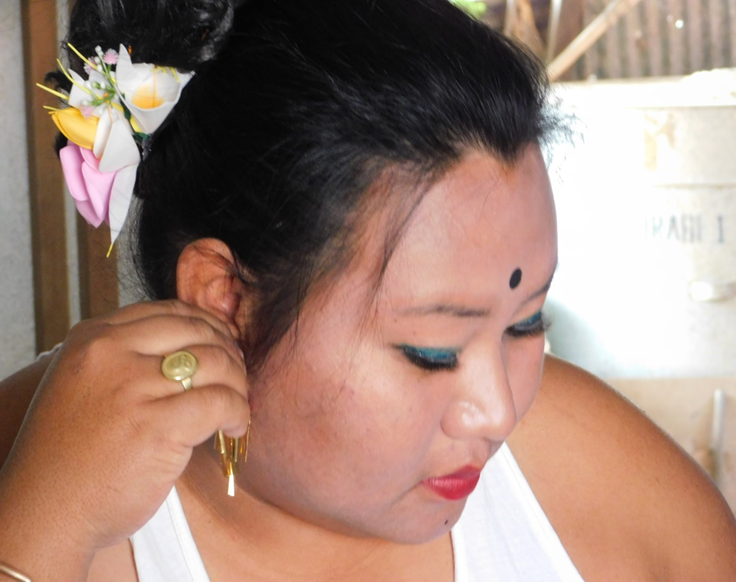 Fig1. Nupa Amaibi
Fig1. Nupa Amaibi
As delved deeper into the study of the Amaibis of Manipur, came across the intriguing idea of the Nupa Maibi, which gave me a fresh perspective on gender roles and performances in Meitei society. The function of Amaibis is not limited to single gender identification, in contrast to the Amaiba, whose duties are customarily and exclusively male. Rather, the Amaibi tradition is inclusive, including both Nupi Maibi (female Amaibis) and Nupa Maibi (male-bodied people assuming feminine or priestly positions). The inherent gender fluidity in the Lai Haraoba cultural and ritual framework is reflected in this inclusion. Nupa Maibis’ existence and acceptance challenge rigid binaries and demonstrate that gender is not solely biological in this context, but rather a sacred and performed role that is intricately interwoven with the spiritual and cultural narratives of the Meitei people. The Amaibis: the shaman of Manipur is deeply rooted antiquity, tracing back to a time that predates recorded history. The spiritual practices associated with the Amaibis, particularly those related to shamanism, are considered to be among the earliest forms of religious expression not just in Manipur but across human civilization. Shamanism, with its universal elements of trance, spirit communication, and healing, is widely regarded as one of the oldest spiritual traditions in the world.
Nupa Amaibis: male bodied shaman and Nupi Amaibis according to Numit Kappa
In the context of Manipur, the tradition of Amailon is a distinct form of Meitei Shamanism and is believed to have begun during the era of Chakpa Lamlang Amaibi, a figure prominently feature in the Numit Kappa, one of the most revered Manipuri Puyas(sacred texts). Within this ancient Manuscript it is clearly mention that the Chakpa Lamlang Amaibi is the designated ritual specialist of Tubi Thingkok Laireima, a powerful female deity in the Manipuri Pantheon. This highlights the Amaibi’s role not merely as a ritual performer but as a divine intermediary where someone chosen to communicate with the gods and goddesses through carefully transmitted rituals, chants, and dances.
The Numit Kappa also documents the Sun worship traditions of the Chakpa People, a theme echoed in other ritual texts such as Soubol Lairemma Loutarol and the Yupan thaba ceremonies. These sources also suggest that the worship of the Sun God was not an isolated practice but rather as both physical and spiritual force, and the Amaibis particularly Nupi Amaibis are portrayed as the spiritual disciples of the Sun god, entering trance states and sacred possession. It is clear that the rise of the sun worship and the rise of the Manipuri shamanism occurred simultaneously, each reinforcing the other. The chakpas embedded sun worship into the foundation of the Meitei religious life. Interestingly, this phenomenon was not unique to Manipur. In the early ancient days, various communities across Southeast Asia particularly in what we now know as the Indo- Chinese and Austroasiatic regions also practiced Sun Worship as a part of their animistic and proto- religious cultures. However, as these societies evolved, there was a noticeable shift from the worship of elemental forces like the sun to the veneration of ancestors, reflecting changes in societal structure, cosmology and values. Yet in Manipur, the traces of this sun worship spirituality remain vividly preserved in this rituals, oral traditions and ceremonial roles of the Amaibis. The practice of Manipuri shamanism particularly as embodied by the Amaibis, can be seen not only as continuation of ancient indigenous belief system but also as a living tradition that retains the echoes of Southeast Asia’s shared Spiritual past.
In the Numit Kappa, one of the most revered Manipuri manuscripts, the ritual tradition of the Amaibis is elaborately chronicled, revealing the existence of three distinct schools: Shanglen, Langmai and Phura. Each of these school carries its own unique set of responsibilities, functions, and ritualistic identities with own originated stories. The heads of these schools are known respectively as Chakpa Lamlang Amaibi (for Shanglen), Khabi Lengnou Monbi (for Langmai), and Tubi Ngang yek Tampa Panthoibi (for Phura), designating both their social stature and spiritual authority within the traditional cosmology.
The Chakpa Lamlang Amaibis, in particular, are entrusted with a highly sacred role: the chanting of hymns and invocation to the deities. Their spiritual function is primarily devotional and meditative, rather than performative. During the ritual occasion of Chakpa Panam Haraoba, the Nupi Amaibis are notably absent. This exclusion is not incidental but rooted in the distinct nature of the ceremony itself because the Chakpas in its earliest form was less of a communal festivity and more of a solemn act of ancestral veneration. It was a time when the community turned inward, paying homage to the Umanglai through rituals centered on remembrance rather than celebration. Unlike the later forms of Lai Haraoba which focus on fertility, prosperity and communal harmony, this earlier tradition was closely tied to ancestor worship and the sacredness of the spirit world.
The rituals associated with Umanglai are the Ukrong Hongba, Nung Hongba, and Yum hongba which are led primarily by the Nupa Amaibis (male bodied shamans), who are believed to transcend from other Groups of affiliations and may come from any of the shamanic lineages. Their spiritual practices are deeply embedded in mythological origins. According to the oral traditions of the Chakpa Amailon(ancient shamanic tradition), the emergence of the Nupa Amaibis is traced back to a visionary experience. It is said that a Chakpa Hameng Mellonmit (a visionary elder) journeyed to the celestial abode and witnessed the deities performing ceremonial dances. On returning to the earthly realm, he shared this divine vision with his disciples, giving rise to a form of ritual dance performed exclusively by Nupa Amaibis. This vision not only validated their role in the Ritual but also set them apart as the chosen mediators of celestial energy. Unlike their male counterparts the Nupi Amaibis (female Shaman) do not participate in these ritual dances. Instead, they enter intense state of trance and spiritual communion, believed to be direct disciples of the Sun god a divine connection that is emphasized in Numit Kappa.
The Chakpa Amailon Myths further reinforce the antiquity of the Nupa Amaibis role. These narratives recount how in ancient times during funerary rites, a sacred tree would be placed at the cremation grounds of ancestors and worshipped as a living conduit to the spiritual world. It was the Nupa Amaibis who led these ceremonies, dancing in devotion around this sacred tree. These early rites underscore the long- standing presence and centrality of Nupa Amaibis in the ritual life of the community, pointing to a spiritual lineage that predates many aspect of the contemporary Lai Haraoba tradition.
In essence, the existence of the Nupa Amaibis is not a later development but a foundational element within the Meitei cosmological and ritual landscape. Through myth, and ritual, they continue to embody the ancient ties between the human and the divine, the visible and invisible, the past and present.
The Origin of Nupa Maibis and Nupi Maibis: Shamans
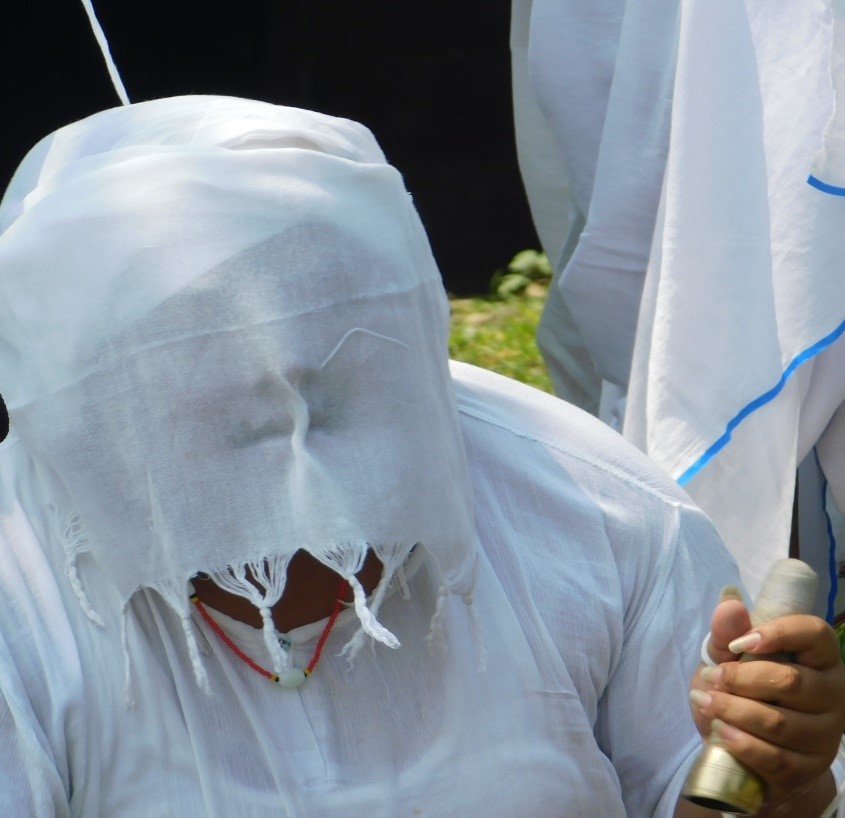 Fig2. Nupa Amaibi giving Oracle
Fig2. Nupa Amaibi giving Oracle
As I explored the sacred responsibilities of the Amaibis, I discovered that there is a significant difference in the methods that Nupa Amaibis and Nupi Amaibis trace their spiritual ancestry, in addition to the existence of gender diversity. Their earliest roots can be found in many Meitei creation mythic eras, each of which reflects distinct ties to divine time and space. The Supreme God, Atingkok Mapu Sidaba, is the root of the Nupa Amaibis. They hold that Attingkok Mapu Sidaba revealed the Tarang Mapao, the divine message that created light and order, at the time of creation, before the universe had taken shape. Ritual, song, and holy knowledge are all born out of this sacred act, which also marks the beginning of the world. Accordingly, the Nupa Amaibis consider Atingkok Mapu Sidaba to be the first Nupa Amaibi, a being who represented heavenly wisdom, ritual authority, and a spiritual fluidity that transcends traditional gender, when he delivered the Tarang Mapao. The Nupa Amaibis regard themselves as vessels carrying out a heavenly mission that was started at the beginning of time, rather than just priests or performers. This mythic connection has a very human quality. Every movement, song, and ritual they carry out is an echo of the first breath of creation, and their identity is more than just a role; it is a legacy.
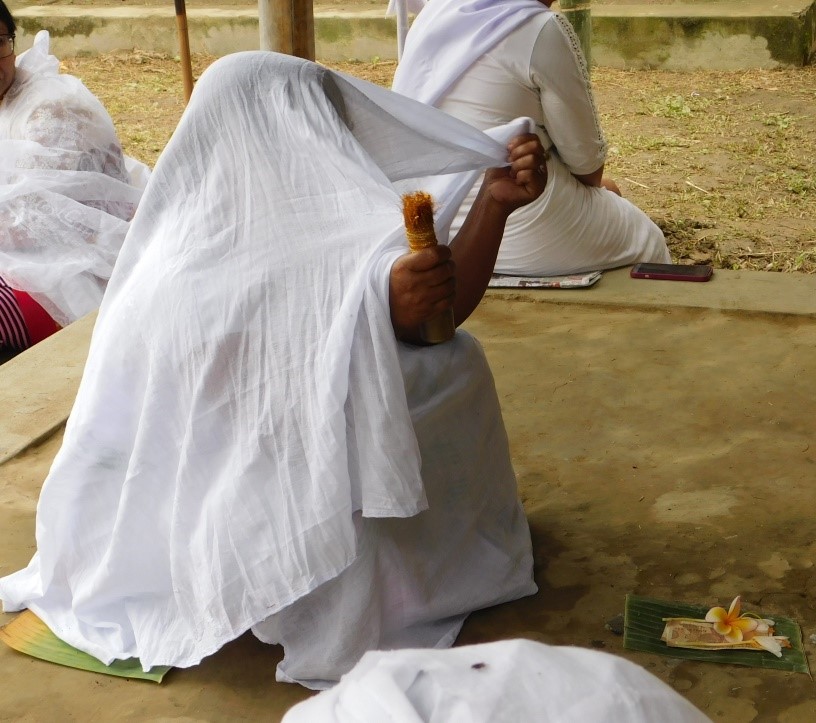 Fig3 Nupi Amaibi giving Oracle
Fig3 Nupi Amaibi giving Oracle
As contrast to the Nupa Amaibis’ ancient origins, the Nupi Amaibis trace their spiritual ancestry to a later period in Meitei cosmology, which is depicted in the epic Numit Kappa, one of the Meitei people’s oldest literary treasures. The setting in which this novel takes place was previously established, but it was still unbalanced. Two suns were hanging in the sky at the time, burning the ground and upsetting the balance of life. In this mythical era of excess and misery, Goddess Panthoibi appears as a cultural reformer as well as a divine feminine force. She was the first, so the story goes, to assume the shape of a Nupi Amaibi, entering the sacred realm of ritual to bring the cosmos back into harmony. The female priestess as we know her now began with her deed, which was both divine and symbolic. There is a profoundly human connection to this mythic event. The creation of the Nupi Amaibi was more than merely a ceremonial event; it was a healing act, a reaction to an imbalance, and a spiritual intervention that restored harmony. In this sense, the Nupi Amaibi tradition is based on a deep act of bravery and caring a representation of Panthoibi’s tenacity and knowledge, transmitted through the generations of women who continue her divine mission.
What connects both lineages is their profoundly human mission. The Nupa Amaibis and Nupi amaibis are two sacred branches of the Meitei Shamanic Tradition, each rooted in myth but alive through human devotion. The nupa Amaibis carry the memory of the first light channeling divine knowledge from the very beginning of the primordial breath of creation, and in doing so, carry the ancient memory in every dance and chant a legacy of wisdom, sacred fluidity, and divine mandate. The Nupi Amaibis on the other hand, born from the goddess panthoibi courage, heals the imbalances with ritual and graces and expressing a tradition grounded in healing, feminine resilience, and cosmic balance. Though their paths are different, both are story teller of the sacred living vessels of care, wisdom and the divine pulse that connects all the things of both worlds. They are mirrors of lived spiritual experience. In a world where gendered roles are often fixed and polarized, the amaibi tradition challenges us to see spiritual identity as fluid, responsive, and deeply relational, a gift carried by those called not only by deities, but by the enduring rhythms of creation and care.
The function of the Nupa Amaibis went well beyond the religious rites of Lai Haraoba at the time when Manipur was a sovereign nation. They were revered by the royal court, supported by monarchs, and given the extremely spiritual responsibility of performing coronation ceremonies, which were intricate rituals governed by antiquated customs and religious symbolism. These rites were more than just ceremonial; they were thought to connect the kingdoms political and spiritual spheres together and consecrate the monarch’s reign with divine blessings. The tradition of the Amaibis, both Nupa and Nupi, is carried on with honour and intention until this day. Being an Amaibi is more than just having a title; it calls for intense spiritual education, in-depth familiarity with Sanamahi customs, and a strong sense of duty. They act as intermediaries between the Lais, the Meitei’s gods, and the human world, and they are defenders of sacred tradition. When life strays from its path, Amaibis are called upon to forecast future events, decipher dreams, forewarn of upcoming misfortunes, and recommend offerings or rituals to bring things back into balance. Even more important is their participation during the colorful Lai Haraoba festivities. Through rituals, dances, and chants, they transform into living channels through which the divine can communicate, cure, and lead the populace
Every motion they make evokes memories of myths, ancestors, and gods, and every word they speak carries the continuity of a culture that views the human and the spiritual as inextricably linked. Not only are the Amaibi skilled in rituals, but they also narrate stories, heal, and guard the Meitei people spiritually.
In seeking to understand the deeper cultural logic of gender identification it kept coming back to Judith Butler’s Gender Trouble in an attempt to comprehend the logic of the culture of gender embodiment within the Amaibi Shamanic tradition of Manipur. Butler’s understanding of gender as a performativity created by means of ritualized repetition and social inscription resonated powerfully with Amaibis‘ lived and sacred experience, despite having a completely different philosophical grounding and historical perspective. The more I learned about the mythic beginnings of the Nupa and Nupi Amaibis, the more I realized how urgent it is to connect these indigenous narratives with gender theory not just for comparison, but also to broaden and entail the frameworks by which we perceive gendered roles.
Since the Amaibis have embodied gendered forms of existence that defy easy classification for generations, this is not an attempt to transpose western theory onto Meitei Cosmology, but rather to allow Butler’s ideas to collide and be challenged by their spiritual and cultural specificities. It is made evident by the process of channeling ritual power and embodying divinity by means of movement, singing, and trance that gender is not a fixed identity but rather a continuous performance that acquires significance through cultural context. But this performance is not only social for the Amaibis; it is sacred, passed down through legendary time, and spiritually performed today.
In order to hold these two worlds Butler’s theoretical provocations and the Amaibis’ embodied mythologies together, I provide connecting reflections here. This allows them to speak across traditions and reveals how ritual, gender, and divinity may be more intertwined than we typically think.
Gender Fluidity and Performance
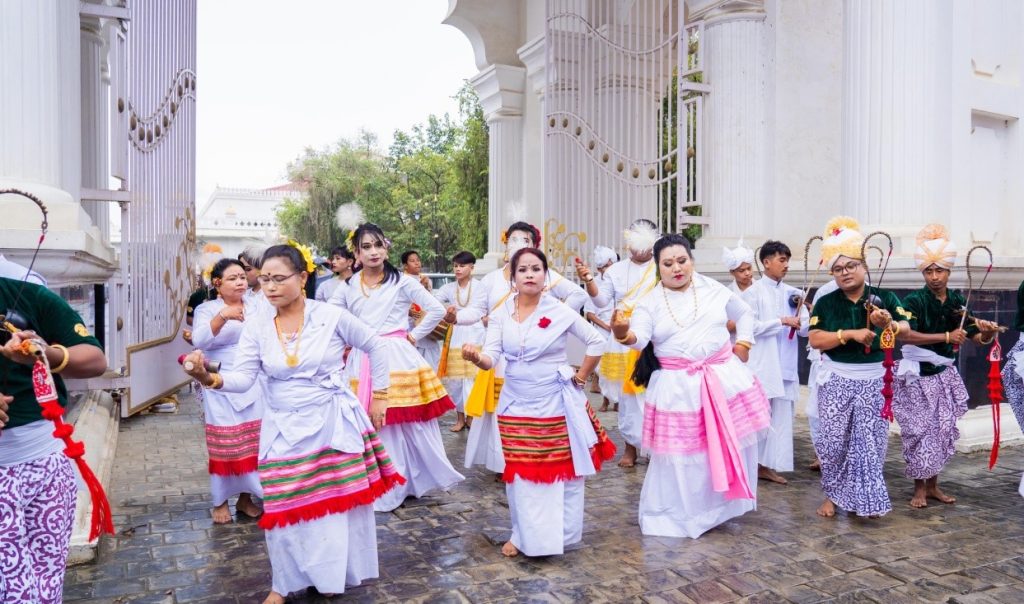
Fig4. Nupa Amaibis and Nupi Amaibis performing welcome dance.
In the Ceremonial space of Laibung during Lai Haraoba, both Male and female Amaibis i.e. Nupa Amaibis and Nupi Amaibis takes part in the ritual performances, often blurring the boundaries of gender through their embodied expressions. What becomes particularly striking is how the Nupa Amaibis( male bodied Shaman) gracefully embody the feminine dance style marked by soft, feminine movements traditionally associated with women clearly seen in the Laiching Jagoi , Panthoibi jagoi , longkhong and so on. They deeply perform the gestures and body language in a way that transport their masculine selves into a feminine realm, allowing for a fluid crossing of gender roles through dance.
Conversely, in segments such as Kanglei Thokpa (lai nupi thiba), which involve more vigorous, masculine movements like wrestling or racing, playing polo with the sticks, Nupi Amaibis take on the role of Male deities. Here, it is the female performer who channels gender binary. This dynamic embodiment reflects a deeper spiritual and ritual transformation, where the performer becomes a vessel for divine expression, regardless of biological sex. Such performative shifts resonate with Victor Turner’s concept of Liminality, where the ritual space becomes a transformative threshold a space between the ordinary and the sacred where identities are fluid, and social roles are temporarily redefined. Richard Schechner’s theories on ritual performance further highlight this embodied transformation within performance spaces, where the physical and symbolic merge in the act of cultural expression.
Bringing in Judith Butler’s theory of Gender performativity, this ritual dance becomes acts that challenge the fix notion of gender. Butler also argues that gender is not something one is, but something one does repeatedly, through gestures, actions and performances. The Amaibi’s ritual dances illustrate this beautifully. Gender here is not a static identity but a performative expression that is continually constructed and deconstructed within sacred and social contexts. Moreover, the insights of the renowned Manipuri writer and cultural thinker M.K. Binodini also enrich this discourse. Her writings on the dances of the Amaibis do not merely document the rituals but delve into the lived experiences, the inner lives, and the social significance of these performers especially in relation to gender, spirituality, and status.
What emerges through these performances is a powerful expression of gender fluidity a movement beyond fixed identities into a space where the body becomes a medium of both spiritual and social transformation. Through dance, the Amaibis transcend the conventional boundaries of Male and Female, embodying a sacred and cultural fluidity that challenges binary definitions. Also, performance thus becomes not only a ritual act but a radical space where gender can be imagined a new open, shifting, and deeply human. Through this study, I aim to bring together these diverse perspectives to explore how gender identity and social roles are not just represented but actively reimagined in the performance of ritual dance space.
Butler renders it easier to consider identity by framing the gender as social performance rather than a biological fact. Her theories challenge inflexible conventions and encourage us to see gender’s diversity and complexity as something that is live and experienced rather than merely assigned. Judith offers a powerful second glance of how we think about gender in her gender trouble (1990). She challenges the conventional belief that gender is fixed, natural or binary construct that can only be classified as male and female. Butler suggest that gender is something we do but nor something we are born with. The way we act, speaks, dress, and behaves in our everyday lives shapes it instead of biology. Butler contends that the appearance of stable gender identities is generated by these repetitive performance behaviours that society has traditionally classified as male and female. In this sense, gender becomes fluid rather than fixed in this way.
Additionally, M.K. Binodini highlights how performance and dance become vital tools for expressing and interpreting gender identities. Although there may be codified roles for Males and females, the roles are not fixed. They can become hazy and change particularly in the mythic and ceremonial contexts. Whether it is a festival ground or a ceremonial space or temple courtyard, the performance space transform into a potent location where gender norm are not only perform but also question, challenged and recreate. According to Binodini, Amaibis offer a deep and complex perspective on gender. She believes that gender is not expressed, molded and reinforce by ritual acts, physical movement, and spiritual performance rather than being fixed or physiological defined. The Amaibis though biological women, do not remain confined to the traditional gender roles. Instead, they take on sacred responsibilities that transcend the male female dichotomy, becoming vessels for both masculine and feminine energy. The Amaibis represent a gender flexibility that is ingrained in their cosmology and belief systems through ceremonial dancing, trance and invocation. In this sense, gender is not just a social construct but also a spiritual act that is done and re-performed within the sacred rhythm of tradition. Binodini does not depict femininity as passive or subordinate. On the contrary, she positions it as powerful, active and essential. The Performative and transformational aspect of gender in Manipuri cultural life is thus highlighted in Binodini’s work.
While holding vastly different cultural and intellectual cultures, Judith Butler and M.K. Binodini both share a compelling insight: gender is a dynamic identity that is constantly performed and created through performance rather than an essential essence. Butler makes the case that gender is performative and molded by recurring behaviors, gestures, and expressions in daily life rather than biology. She bases this argument on the framework of Western feminist philosophy. According to her, gender is not a fixed identity but rather something we do as opposed to something we are. On the other hand, M.K. Binodini uses Manipur’s Cultural and religious landscape to vividly illustrate this concept. Her writings, especially those about the ritual life of Amaibis, the priestess- performers of Lai Haraoba, show how to dance, ceremony and spiritual authority are used to ritually enact, reinforce and even transcend gender roles. Butler emphasizes how gender identities are shaped by repeated social acts in daily life, but Binodini demonstrates how ritual performance in sacred place can have a comparable effect by establishing gender roles while also providing a space for resistance and redefinition. According to Binodini, ritual gives women more visibility, voice and spiritual authority inside patriarchal system, while Butler believes that performance can challenge prevailing gender stereotypes.
Essentially, the two intellectuals highlight that gender is a lived, performed, and socially mediated reality rather than a static term. Binodini provides the lived embodiment of this concept through the ritual activities of the Amaibis, while Butler provides the theoretical framework of performativity. Collectively, their viewpoints serve as a reminder that gender is constantly being created and reconstructed through the power of performance, whether it is in a sacred space or on the street.
In Ritual performance context, The Lai haraoba ceremonial dances clearly demonstrate aspects of gender fluidity, identity, and the body’s transformation and movement. Both male- bodied Amaibis (Nupa Amaibi) and Female – bodied Amaibis (Nupi Amaibi) performed sacred rituals such as Laiching Jagoi, Panthoibi Jagoi, Longkhon Jagoi etc in temple spaces. The Amaibi’s bodies embrace feminine postures: their hand, heads, waists, necks and feet all move gracefully, delicately, and fluidity. In trance dance sequence and the dances like Kanglei thokpa and other dances, the transformation is even more remarkable. During these moments, the Amaibis encounter embodied metamorphosis that allows for significance changes in the body and presence. Here, I connect with the victor turner’s concept of liminality, transformation and transportation of the bodily movements as the performer’s body transform and transcend into another self-ritual realm. Additionally, the concepts of ritual performance and restored behavior developed by Richard Schechter offer a useful framework for examining, enactments that connect practitioners to ancestral and celestial realms. At Lai Haraoba, the trance states of the Nupa and Nupi Amaibis demonstrate not just a bridging of gendered embodiment but also the potential of performance as a vehicle for social and spiritual transformation.
A detailed examination of the trance dance performed by the Nupa Amaibis and Nupi Amaibis during the Lai Haraoba rituals reveals a relation between ritual practice, identity and transformation. Turner claims that rituals involve a liminal phase, also known as a threshold moment, where the dancers temporarily disassociate themselves from their predetermined identities and social places. Transformation is made possible in this symbolic space, practitioner feels a sense of communitas, shared emotional and spiritual connection that transcend social hierarchies in this sacred space. The dance of the Lai haraoba marks the entry of both male and female Amaibis into this transitional era. The bodies are changed into sacred vessels that are open to the divine’s presence and manifestation of the divine for a transitory yet powerful moment. Through ritual gestures, invocations, stylized movements and states of possession, the Amaibis perform a sacred transformation that not only changes their physical form but takes them to a new spiritual dimension. The movements is vividly seen in the key segments of the ritual dance particularly Lai Nupi thiba, Laipao chenba etc where the boundary between the human and divine becomes hazy and the transformation and transportation of the body movement is clearly visible.
As the Amaibis embody divine energies, they draw the entire community into a shared spiritual experience. The performance turns into a group experience that strengthens shared values, cultural memory, and the continuity of the tradition. Thus, the Amaibis trance dance is a collective reaffirmation of identity, spirituality, and cultural unity as well as very intimate act of embodiment.
Conclusion
The sacred performance of the Amaibis in the Lai Haraoba is far more than ritual it is a living expression of Meitei cultural memory, and it shared identity, spiritual embodiment. When the Amaibis enter trance and surrendering themselves to divine energies, their dance becomes a collective act of devotion. The entire community participates in the spiritual reaffirming ancestral ties and cultural continuity. In a ritual segment like Lai Nupi Thiba and Laipao Chenba, the human body becomes a sacred vessel open to divine presence, transformation of the bodily movement and transcendence. In these moments, the boundary between the human and supernatural powers, the self and the spirit dissolves.
Both the Nupa Amaibis and the Nupi Amaibis are vital to this ritual practice. Their presence is not symbolic or marginal it is a central. Through the ritual dances such as Laiching jagoi, Panthoibi jagoi, and Longkhon Jagoi, the Amaibis enact a spiritual language where gender is not fixed or binary, but fluid, embodied and sacred. The graceful movement is seen in the bend of the neck, the tilt of the hand, the softness of the feet reveals that sacred performance transcends the body’s assigned gender roles. In this performance space it is not one’s sex but one’s capacity to carry the divine that defines one’s role.
The role of the Nupa Amaibi, in particular calls us to rethink modern assumptions about gender roles. Far from being a recent or exceptional phenomenon, the existence of Nupa Amaibi is well rooted in ancient Meitei literature and Puyas, where their rituals and spiritual duties are clearly recorded. This long standing presence affirms that Nupa Amaibis have always been a part of the sacred world of Meitei cultural tradition not as an exception but as a divine necessity. In today’s society where gender nonconformity is still often misunderstood or judged, the Nupa Amaibis offer a vital lesson. Their role is not something to be looked down upon; it is a role that is chosen not by the society but by the divine.
To be an Nupa Amaibi is not merely to perform feminity; it is to carry the same weight of the ritual carry by the Nupi Amaibi, the power of transformation and the beauty of divine embodiment. It is a rare and sacred calling. Nupa Amaibis are quite simply a god chosen and not everyone can become one. Their existence is a gift to the cultural soul of Manipur a living reminder that spirituality like gender is not limited by human constructs but open by divine purpose.
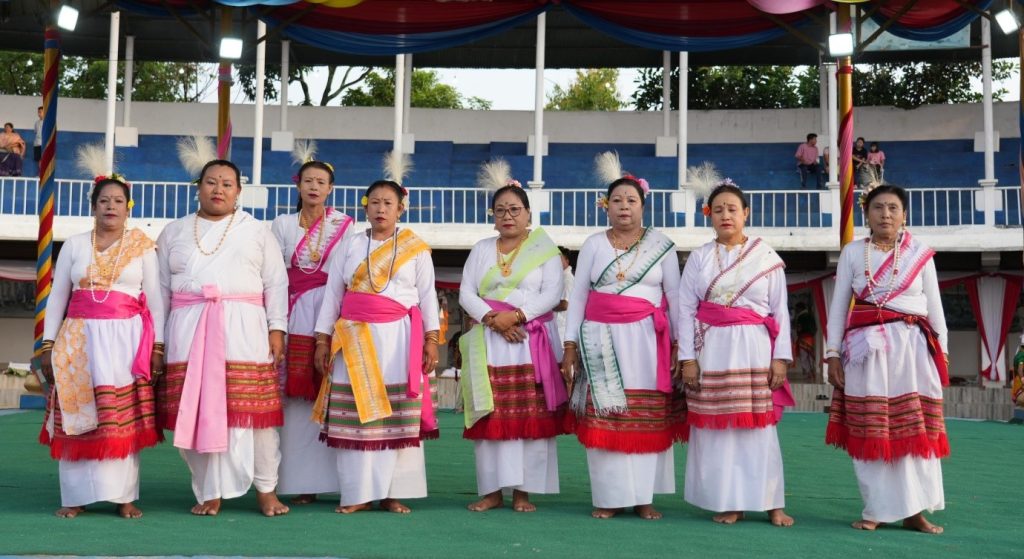
Fig5. Ima Amaibis
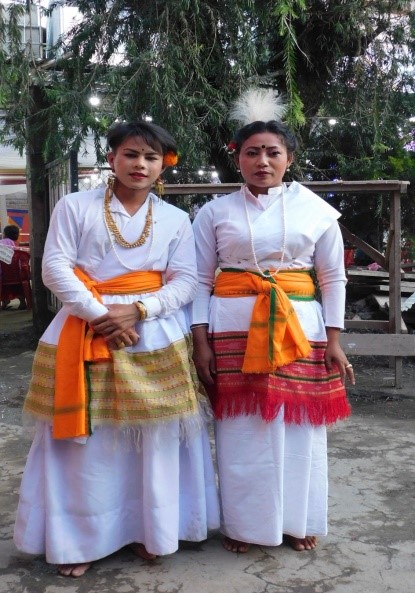 Fig6. Nupa Amaibi & Nupi Amaibi
Fig6. Nupa Amaibi & Nupi Amaibi
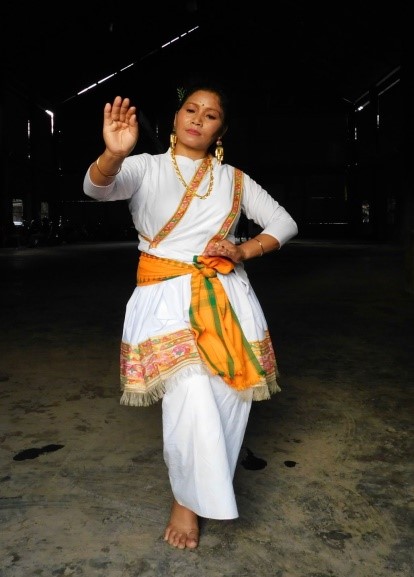 Fig7. Nupi Amaibi
Fig7. Nupi Amaibi
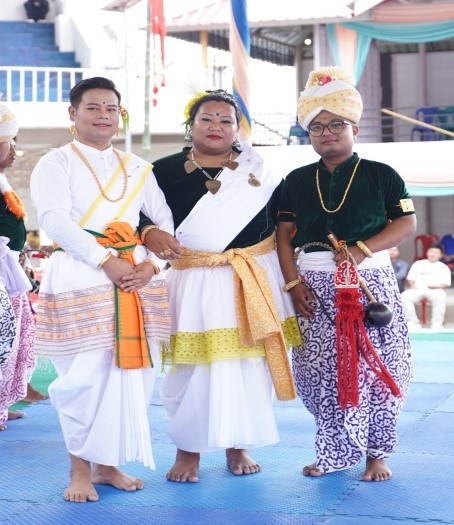 Fig8. Nupa Amaibi & Pena Asheiba
Fig8. Nupa Amaibi & Pena Asheiba
Reference
- Memchoubi, Arambam. Manipur da Shamanism. Imphal, Lamyanba Printers, 2005
- Paratte A, Saroj Nalini J. The Pleasing of Gods: Meitei Lai Haraoba. New Delhi: Viskash publishing house; 1997.
- Hodson, TC. The Meitheis. London: David Nutt; 1908.
- Roshan, LS. The Meitei Maibis (shaman) of Manipur: A psychological perspective. New Delhi: Akansha Publishing House; 2020.
- Premchand, Nongthombam. Ritual and Performances: Studies in traditional theatres of Manipur. Imphal, 2005.
- Schechner, Richard. Performance Studies: An Introduction. 3rd edition, New York Routledge; 2013.
- Turner, Victor. The Ritual Performance: Structure and Anti- structure. Chicago, Aldine publishing; 1969.
- Maibi, Kumar. Kanglei Haraorol. Imphal; Lamyanba Printers; 2001.
- Bowers, Faubion. The dances in India. New York: Columbia University press; 1953.
- Akaseni devi, Dr Ngangom. Meitei Amaibi. Jayshankar publication; 2006.
- Butler, Judith. Gender Trouble: Feminism and the Subversion of identity.
- Haobijam Siddharth. The Amaibis of Manipur: Gender fluid priestesses of the Sanamahi Religion. Sahapedia: An open online resource on the arts, cultures, and heritage of India. www.sahapedia.org.